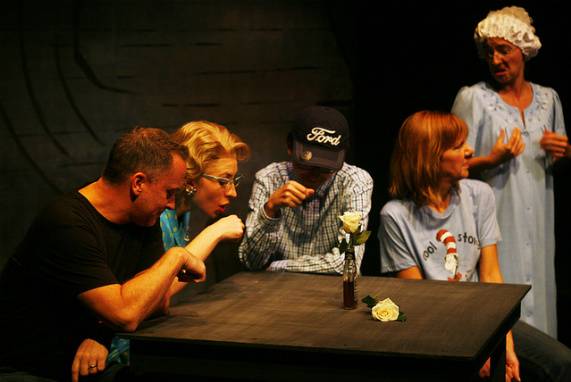
A friend recommended How I Learned to Drive to me, though he doesn’t know it. He mentioned it during a conversation at a conference we were both attending. He’s the kind of person who is easy to admire: interesting, learned, cultured. And he seemed to think I was these things too, so when he mentioned Paula Vogel and her play, assuming that I was familiar with them, I did what a lot of people do at conferences. I nodded and gave some kind of “Oh yes! I know! It’s brilliant!” response. I didn’t want to disappointed him, you see. After the conference I promptly borrowed the play from my library and improved myself as a human being.
Last week, Smile Politely published an excellent preview of the Station Theatre’s production of How I Learned to Drive, and I won’t elaborate further on the play’s controversial and important topic. But I understand what Thom Schnarre (the play’s director) means when he describes healing and survival as somehow being achieved “without a map.” There are different kinds of healing, and compassion can be shown in vastly diverse ways. Far too often justice isn’t possible to attain, only mercy.
The Station’s stage production of Vogel’s play opened on October 4. Drive has only five cast members — two main characters: Li’l Bit (Chris Taber) and Uncle Peck (Thom Miller); and three supporting characters: Adult Greek Chorus (J. Malia Andrus), Male Greek Chorus (Nic Morse), and Teen Greek Chorus (Sarah Heier). The Greek Chorus provides background, insight into Li’l Bit’s upbringing, and sometimes comic relief. Most often, the chorus plays various members of Li’l Bit’s extended, dysfunctional family.
When we first meet Li’l Bit, she’s seventeen years old, and she’s looking forward to going for a drive with a man “old enough to be [her] father.” That’s creepy enough, but it doesn’t take long for us to learn that this guy isn’t just a creepy guy. He’s Creepy Uncle Peck. And worse yet, compared to the rest of Li’l Bit’s relatives, Creepy Uncle Peck is kind of endearing.
Indeed, Li’l Bit’s entire family is horrid. She’s surrounded by ignorance, bitterness, and sometimes outright cruelty. Her stupid, puerile grandfather verbally sexually harasses her at every turn. Her complaining, repressed, misandrinistic grandmother lies to her about the very things that young girls going through puberty should be told the truth about. Her jealous, petty aunt — aware of what’s happening to her — blames the victim. And her boozy mother, at the very moment that Li’l Bit needs her the most, unwittingly does the same.

Left to right: Thom Miller, J. Malia Andrus, Nic Morse, Chris Taber, Sarah Heier
So when Uncle Peck encourages Li’l Bit to study, when he supports her dreams to go to college, when he worries about her driving abilities, and implores her to always be safe, we can’t help but be grateful for these moments of real care and love in Li’l Bit’s life. I found myself, early in the story, wanting everything to be alright, and thinking, “Well, she’s seventeen. She’s of age. He’s much older, sure, but this could be worse. She’s not afraid or even put off by him. There’s real love here. As long as he follows the campsite rules, it’s not too terrible, right? He could get her the hell out of here. Maybe that’s what all the driving metaphors are about?”
 But soon, we come to understand that How I Learned to Drive is a nonlinear narrative, and Li’l Bit’s story is darker and more disturbing than we’ve been led to believe. There’s more going on here, the gray areas vanish, and soon the audience’s laughter dies down, and then disappears entirely.
But soon, we come to understand that How I Learned to Drive is a nonlinear narrative, and Li’l Bit’s story is darker and more disturbing than we’ve been led to believe. There’s more going on here, the gray areas vanish, and soon the audience’s laughter dies down, and then disappears entirely.
“Family is family,” Uncle Peck tells Li’l Bit. He repeats this platitude throughout the years that he’s violating her. Ironically, it’s when he attempts to tell her that they’re not family — not blood related, so it’s OK — that Li’l Bit is finally able to break the hold he has on her.
How to tell this story properly? How to stage it? Until last week, I’d only read the play. And as the lights dimmed in the Station on opening night, I couldn’t imagine how a topic such as this one could be respected, told honestly, and performed the way that Vogel meant it to be told. Would the characters on stage be similar to how I’d imagined them? Would they speak in the voice that my mind’s ear had given them? I don’t usually worry about these things when seeing a production for the first time. But this topic is different.
I had nothing to worry about. The cast for Drive is magnificent. Chris Taber and Thom Miller are simply perfect choices for the difficult, complex roles of Li’l Bit and Uncle Peck. Taber wisely plays the part of Li’l Bit as an adult throughout the story (no matter what age her character is at the moment), and this prevents any distraction that doing otherwise would cause. Whether we’re watching Li’l Bit’s experiences at the age of seventeen, or fifteen, or younger, we see a strong, intelligent woman, and thus we never forget that we’re witnessing this story through the eyes of someone who is now grown, and ready to forgive and perhaps even understand.


Thom Miller astounded me. Somehow, he is able to find a way to portray this character — this despicable character — in a way that doesn’t repulse. It’s clear that Vogel wanted to make sure that, underneath his sins, we see kindness in Uncle Peck, and Miller is able to bring that forth. But nothing is whitewashed. Amidst the kindness, there are the sins. Thus, Uncle Peck isn’t just making Li’l Bit uncomfortable. He’s not just manipulating her emotions. He’s making us uncomfortable; he’s manipulating our emotions as well. This kind of role must be enormously difficult to pull off, and Miller manages it flawlessly.
 Another cast standout is J. Malia Andrus. Two of the crucial characters that Andrus, as the Adult Greek Chorus, portrays is Li’l Bit’s Mother and Aunt: two women in Li’l Bit’s life who could help her, but choose not to. They are broken, mean women, products of their own ignorant, dysfunctional upbringing. But Andrus finds a way to give each character a type of strength that is admirable. The mother does love her daughter in her way, and tries to debunk some of the grandmother’s more outrageous assertions about men and sex. And the aunt isn’t completely wrong when she accuses Li’l Bit of being just a bit “sly.”
Another cast standout is J. Malia Andrus. Two of the crucial characters that Andrus, as the Adult Greek Chorus, portrays is Li’l Bit’s Mother and Aunt: two women in Li’l Bit’s life who could help her, but choose not to. They are broken, mean women, products of their own ignorant, dysfunctional upbringing. But Andrus finds a way to give each character a type of strength that is admirable. The mother does love her daughter in her way, and tries to debunk some of the grandmother’s more outrageous assertions about men and sex. And the aunt isn’t completely wrong when she accuses Li’l Bit of being just a bit “sly.”
And I would be remiss if I didn’t mention the mother’s lesson to her daughter on how to drink like “a lady.” It’s bawdy, refreshingly funny, and even a little sexy. This monologue is difficult, animated, and quite long, and Andrus doesn’t miss a beat. She completely owns this scene.
The execution of How I Learned to Drive went off without a hitch on opening night. The music chosen for both before and during the show is enjoyable and quite appropriate to the story. The costumes work very well, as do the clever costume changes, especially considering how many characters the supporting cast plays.

The set direction is also impressive in that it’s so deceptively simple. Everything on stage, from the double entendre statements painted on the walls (“dangerous curves ahead“), to the table setting, to Li’l Bit’s dorm room highlights the ambiguous ride on which Vogel’s script takes all of us, almost against our will.
How I Learned to Drive is a troubling, funny, infuriating, and ultimately heartbreaking ride, but one worth taking.
~~*~~
How I Learned to Drive is playing at the Station Theatre every Wednesday–Sunday until October 20. Showtime is 8:00 p.m. and ticket prices range from $10–15, depending on which night you attend. Reserve your seats here.
All photos by Eric Ponder.







